The moment “Ten hero guitars” was published on AudioCulture around Christmas 2019, and every time it’s been shared on social media since, feedback has been crammed with worthy absentee axes.
Where was Jon Toogood’s Telecaster Deluxe Custom? Where was Jed Town’s Travis Bean with its aluminium neck? Where was Paul Kean’s homemade Barracuda bass guitar? Paul Kean himself even dove into the comments on that one!
Well, those three are included here as well as seven more. Not necessarily the prettiest, most expensive guitars going around, but instruments with unusual or interesting stories that are special to or synonymous with these New Zealand musicians.
Jon Toogood’s Fender Telecaster Deluxe Custom
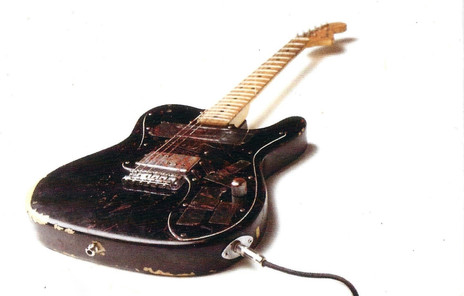
Jon Toogood's Fender Telecaster Deluxe Custom
One of New Zealand rock music’s most striking images is that of the bloodied and gaffered mid-1970s Fender Telecaster Deluxe Custom of singer/guitarist Jon Toogood in the CD booklet of Shihad’s 1999 album The General Electric.
Captured by photographer Dave Reimer, the Tele rests post-gig. The neck pick-up is taped over with gaffer tape, the toggle switch at the top of the body has been removed and taped over, as have both tone knobs and the volume knob for the neck pick-up. But most eye-catching is the amount of blood sprayed and smeared over the instrument.
“Yeah, that’s my blood,” Jon Toogood confessed. “It was before I learnt to maybe hold off a little bit. Because I’d just get too excited and smash the crap out of my … Yeah, it was almost like I was addicted to volume, and I was addicted to feeling. So, if I wasn’t feeling it, I’d probably push a little bit too hard at a show.
“The reason the tone switch was taken out was because I would always hit it when I was playing and then go to the neck pick-up, and that’s really dull-sounding. It would just be a pain in the arse. So, we took it out. I never do anything with a tone knob. I’m a rhythm guitarist, I never needed to turn the tone knob down, so we just took that out as well. It was just one less thing to fuck up live, basically. It made it foolproof. There’s your volume knob, turn it up, play, turn it off.”
The guitar originally belonged to Shihad’s guitar tech John Kingston and Toogood would borrow it until finally convincing Kingston to sell it to him. Toogood first fell in love with the Telecaster shape as a kid watching Purple Rain, in which Prince played a Hohner Mad Cat Tele copy. “It was the sexiest thing I’d ever seen,” he said.
Jed Town’s Travis Bean TB-1000A
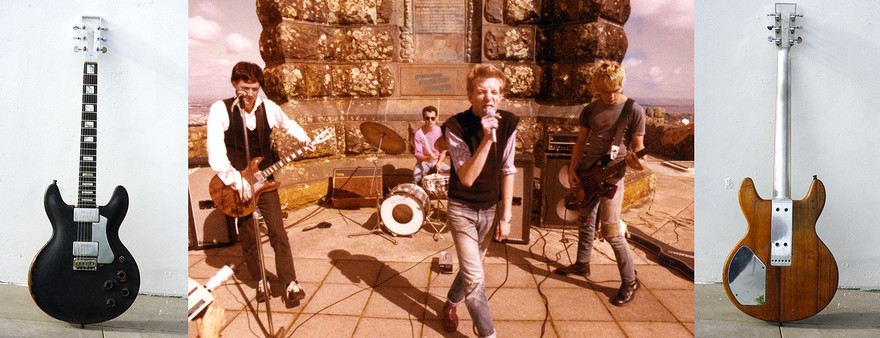
Jed Town's Travis Bean TB-1000A in action with the Features. Left to right: Jed Town, James Pinker, Karel Van Bergen, Chris Orange - Photo by Jonathan Tidball
While on a meditation retreat in Florida in the late 1970s, post-punk guitarist Jed Town took a day to check out Miami and found a Travis Bean TB-1000A electric guitar in the first music shop he walked into.
“This was up half-price,” Town said. “It was US$500. It was like I was just destined to go there. I was just following my instinct. I would never have planned anything like that, it just happened. It was just surreal.”
A Californian luthier and machinist, Travis Bean started Travis Bean Guitars in 1974, building electric guitars and basses with machined aluminium necks. Humbucker pick-ups were mounted directly to an aluminium centre section that ran through the body, making the guitars heavier than even a Les Paul.
“I had a kinda premonition that punk was going into something slightly more intense or something,” Town said. “And I had this feeling I needed a metallic-sounding guitar, and it just took me there. And when I got that, The Features kinda turned up in late 79, and I’d been using that for a few months. It was a totally different sound. It was a nasty sound.”
Number 1198 of about 3600 Travis Bean guitars and basses produced between 1974 and 1979, Jed Town’s TB-1000A was painted black because he didn’t like the colour of the solid Hawaiian koa wood.
Paul Kean’s Barracuda 001 bass
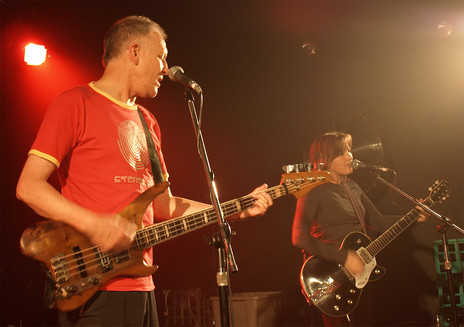
Paul Kean with his Barracuda bass, East Brunswick Club, 2010. - Peter Russell
Keen to establish an individual bass guitar sound, a young Paul Kean crafted his own instrument out of native red beech. Initially intending to name the guitar after the Māori term for the timber (tawhai raunui), he opted instead for Barracuda.
“I was gonna give it the Māori name for red beech, but then I kept forgetting it,” he said. “But I’d also been fascinated with fish around that time, screen-printing different fish shapes and body shapes, and the barracuda I’d just always loved. I think it might have been from some Diver Dan [TV show] or something like that as a kid.”
A fan of English prog-rock band Yes, Kean loved the bright sound of their bassist Chris Squire. “I wasn’t influenced by his style at all, but I liked his sound. So, I kinda went about trying to figure out where they placed the pick-ups in all those different basses and measuring them all. I found the spots where all the sweet sounds I loved were and then I placed my pick-ups; a big, fat DiMarzio pick-up on the neck side and then a Fender Jazz pick-up down at the bridge.”
He bought a neck and machine heads from Neville Claughton’s shop on Colombo Street, Christchurch. The prototype body was a lump of mahogany, but “it sounded like shit” so was passed over for a piece of red beech shaped to fit Kean’s body. At first it had outputs from both pick-ups, but it became too tricky when touring using rented backline. “I ended up modifying it somewhere along the line.”
The Barracuda 001 made its first appearance with The Basket Cases, aka The Detroit Hemroids, in the late 1970s. “It’s had a long life,” Kean said. “And I promised to bring it out for this Port Noise thing we [The Bats] did in March. Because it’s local, so I’m not lugging it around the country!”
John Grenell’s Gallotone
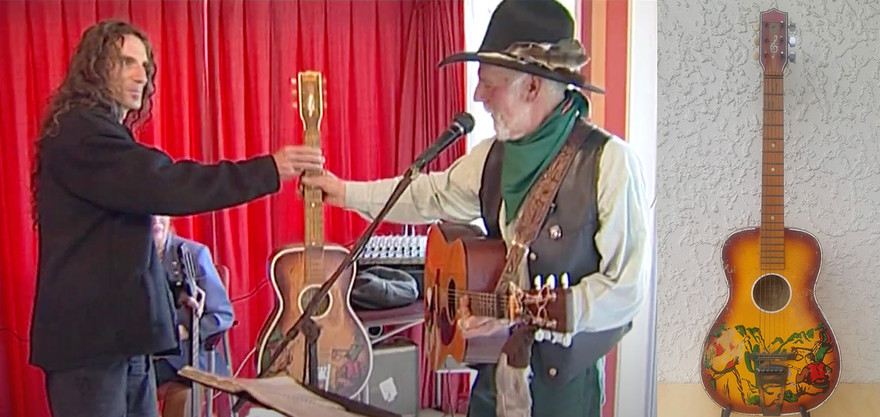
John Grenell’s Gallotone, handed back to him by Graham Shaw at the Woodcote Retirement Village. Right: Musical instrument retailer Neville Claughton’s Gallotone was so similar to John Grenell’s that Grenell’s friends thought it was the seized instrument and inquired about getting it back. - Joe Morgan, Neville Claughton
New Zealand country music icon John Grenell’s Gallotone acoustic guitar hit the headlines for all the wrong reasons in 2008 after it was seized by Ministry of Justice bailiffs and sold at auction in lieu of unpaid traffic fines.
After a brief stay in hospital, Grenell returned home to his Whitecliffs property, in the Canterbury foothills, to find bailiffs had removed the guitar along with musical equipment that belonged to his children, a friend’s amplifier and Grenell’s late grandfather’s mandolin.
Grenell appeared on radio and in newspaper pleading for the return of the Gallotone that he had bought as an 11-year-old from a second cousin in the mid-1950s. He revealed the guitar was probably the one he was playing when he was spotted by promoter Joe Brown at a talent quest in Naseby in 1963.
Luckily, the Gallotone was bought at auction by musician Graham Shaw, who knew Grenell from his Whitecliffs festival events. “A few days later the auction house rang me,” Shaw said. “They had been approached by John’s family to reach out to whoever bought it.” It was returned to Grenell at a gig at Woodcote Retirement Village a few weeks later.
The South African-made Gallotone guitar is the same make that Quarrymen leader John Lennon was playing when he was introduced to Paul McCartney at a village fête in Liverpool on 6 July 1957.
Tina Matthews’s Hofner Violin bass
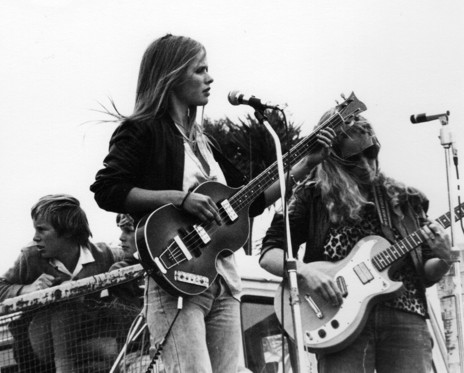
Tina Matthews in the Wide Mouthed Frogs, performing at a Wellington Summer City event
Originally borrowing the Hofner Violin bass belonging to Wellington writer and musician Nick Bollinger in the late 1970s, Wide Mouthed Frogs bassist Tina Matthews loved it so much she bought her own, ironically from her eventual replacement in The Crocodiles, Jonathan Zwartz.
When Matthews left the Frogs for The Crocodiles, she moved to a powder-blue Fender Telecaster bass, but not of her own volition. “The menfolk in the band felt I’d sound gruntier if I moved off the Hofner,” she told AudioCulture. Having long ago sold the Tele, she still owns the Hofner.
It played a role in the formative years of Matthews’s son, Hal Strewe, now a working bass player in Germany. He was a member of the Cassette Head sessions that hosted weekly jams in Berlin with local and international guests. The events were recorded live to cassette and tracks released on YouTube.
“My son Hal continues to play the Hofner when he returns to Sydney,” Matthews said. “He loves the warm sound for both playing and recording. I loved it too. The miracle is that he can make a living playing the bass and is a much better player than I ever was. Having the Hofner round the house when he grew up probably sparked that interest, I think. It was a real pleasure to play, and it still is.”
The hollow Hofner 500/1 Violin bass was introduced in 1955 and found fame and its nickname the “Beatle Bass” when adopted by Paul McCartney after he assumed bass duties from Stuart Sutcliffe during the Beatles’ Hamburg years.
Johnny Volume’s
Gibson Les Paul Junior

Johnny Volume with his Les Paul Junior, Windsor Castle 1978.. - Murray Cammick
When Lou Reed was in New Zealand in October 1977, Scavengers guitarist Johnny Volume took the opportunity to attend his Auckland press conference and take along the guitar he had bought that reputedly once belonged to Reed. “I took the Les Paul Junior with me and a photo of Lou playing it, hoping to get Lou to authenticate it and sign the photo,” Volume recounted.
Reporters were firing ridiculous questions at a wary Reed when suddenly Volume accidentally stepped on one of the cables running from the video camera of Reed’s transgender muse Rachel Humphreys. “Hey, asshole, get off that lead,” Reed snarled, and any thought of Volume pulling the Les Paul from its case evaporated.
“After everything that happened there, I thought, ‘I’m not gonna fucking piss him off any more,’” Volume said. “Afterwards, when I told someone that Lou Reed had called me an asshole, the word quickly spread all over Auckland and seemed to boost my credibility, ha-ha!”
A few years later, when Volume was in Melbourne with Marching Girls, the Les Paul Junior was stolen after a gig. Volume went to a seedy music shop on Chapel Street to try and organise to borrow a guitar for the night. When he told the staff about the theft, they told him to return later that afternoon.
“So, I went in in the afternoon and sure enough the guitar was back in the shop and the guy was there and said he’d just found it on the road. Fuck off, no way. [Band manager] Dave Russell’s the most particular guy in the world, he’d never leave a guitar lying on the road. He said, ‘Can I have a reward?’ I said, ‘Fuck you,’ and just grabbed the guitar and walked out of the shop.”
For more about the purchase of, damage to and sale of the Les Paul Junior, read “Johnny Volume: The Scavengers and the early days of NZ punk – part two”.
VGB’s 1976 Fender Telecaster Thinline
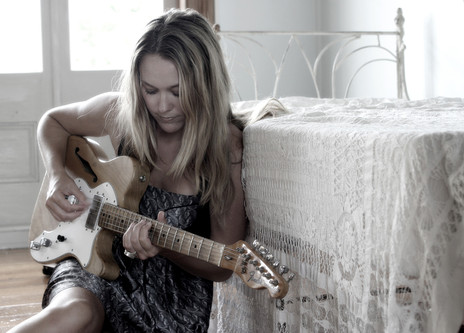
Victoria Girling-Butcher - Smash Photography
Dave Dobbyn’s go-to gag when introducing his band’s rhythm guitarist Victoria Girling-Butcher to an audience is to state that her parents presented her with a brand-new Fender Telecaster Thinline on the date of her birth in 1976.
But in fact, Girling-Butcher, who uses the stage name VGB, bought the Tele from a friend in Taranaki in 2005 or 2006. When she expressed an interest in purchasing it, the owner had to go searching for it because he had moved house, and it wasn’t where he thought he’d stored it.
“The intonation was still perfect,” Girling-Butcher said. “It didn’t have a case, but it was presented to me in perfect condition. It’s a very, very reliable, sturdy guitar for live because it’s really solid. It’s really beautifully harmonically settled.”
She even came up with a backstory for the semi-hollow instrument. “I feel like in my mind, my fantasy history of this guitar was that it was played in covers bands night after night through the 70s and 80s sometime, in Taranaki. I’m envisaging these covers bands playing pubs, because it feels like it’s been played a lot.
“When you have a relationship with an instrument that’s that close, it feels like, you know, second in line to my daughter. On a par with the family pet, you know. If there were a house fire I’d save the child, and then which one, the cat or the guitar? I’m not sure.”
Since returning to New Zealand in 2019, Victoria Girling-Butcher and her Fender Telecaster Thinline have been integral parts of Dave Dobbyn’s live band as well as part of Th’ Dudes for a national tour in 2020.
Nigel Gavin’s Laurie Williams
seven-string acoustic
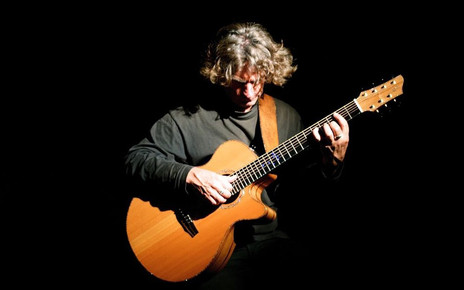
Nigel Gavin with his Laurie Williams-built seven-string acoustic guitar
Gitbox Rebellion founder and director Nigel Gavin was already in possession of a bespoke seven-string acoustic guitar built by Mangōnui luthier Laurie Williams when the two men crossed paths at a guitar festival in Northern California 15-odd years ago.
“All the luthiers were playing, showing off their wares, and he was there,” Gavin said. “And he had a seven-string guitar sitting on a stand. He said, ‘That’s your new guitar. I want that one back.’ I said, ‘No way.’ And he says, ‘Well, you’ve got an hour to choose.’”
So, Gavin set about comparing the two and decided the newer one was “slightly better”. The electronics had been moved from outside to inside and Williams had fitted the later one with battery-operated lights; Matariki lights on the 12th fret, then side marker lights on the side dots.
“Because I had asked him with the previous guitar, I said, ‘The side markers, if you could put them slightly concave to catch the light.’ I do a lot of improvising and I need to see what I’m doing when I’m improvising. And then when I saw this guitar at this festival in California, he said, ‘It’s got lights in it.’ I said, ‘What?!’”
Laurie Williams has been a professional guitar builder since 1993 with his focus on indigenous New Zealand wood, often down to milling or resawing logs himself and stacking and drying timber on his Far North property. “He’s a perfectionist; perfectionists sometimes are a bit annoying,” Gavin laughed.
Liz Stokes’s G&L Tribute Fallout

Elizabeth Stokes at the Splendour in the Grass festival, Australia, 2019. - Claudia Ciapocha
Beths singer and guitarist Liz Stokes is proud and quick to point out that her G&L Tribute Fallout guitar was made in Indonesia, which is where Stokes was born; Jakarta to be precise.
“I wanted a guitar that was light and small, and I tried all the usual suspects, but nothing really spoke to me,” Stokes told Australian Guitar editor-at-large Ellie Robinson. “I think I can be a bit contrarian, and I liked the idea of having a guitar that not as many people did.”
The G&L guitar company was founded in California in 1979 by the designer of the Telecaster, the Stratocaster and the Precision Bass, Leo Fender, and his former Fender Electric Instrument Company employees George Fullerton and Dale Hyatt. The G&L moniker is for George and Leo.
“I watched a few video reviews of the Fallout and liked that it had both a P-90 and a humbucker, which you could blend, and the blend has ended up being my go-to pick-up setting,” Stokes told Robinson. “The first time I held one in a shop it just felt right, the neck felt smooth and well-made, and the body was light and comfortable. And it was pretty cheap, too!”
Introduced in 2003 as a cheaper alternative to the US-built instruments, the G&L Tribute series was briefly manufactured in Japan before moving production to South Korean guitar company Cort’s facilities in South Korea and Indonesia.
Phil Whitehead’s Roland GS-500 guitar controller and GR-500 guitar synthesiser
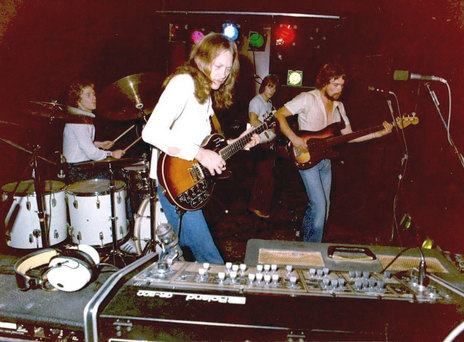
Think in New Zealand, 1979. Left to right: Mark Nash, Phil Whitehead using the Roland GR-500 guitar synthesiser and expander, Steve Lunn, Allan Badger.
In 1979, after splitting up in Melbourne the year before, prog rock band Think reconvened in New Zealand with the intention of honing their sound for another assault on Australia. Guitarist Phil Whitehead approached Roland NZ in the hope of acquiring the brand-new Roland GR-500 synth module and guitar controller.
A joint venture between Roland and Japanese guitar builder FujiGen, the modified GS-500 guitar and GR-500 synth were released in New Zealand at a music trade fair at The Auckland Town Hall in the late 1970s. Around the same time, Steely Dan and Doobie Brothers guitarist Jeff “Skunk” Baxter visited to present workshop demos of the instrument.
As stated in the instruction manual: “Five sections of instrumental sound may be combined in any manner to achieve sounds such as guitar with electric bass, or brass combined with violins, synthesiser and French horn. Polyphonic voices may be combined with a six-tone guitar sound to achieve combined ensembles of sound.”
Although no longer certain of the details of the deal, Roland NZ’s then-boss Murray Cullen believed Whitehead would have been given loan of the product in exchange for making in-store appearances and demos of the guitar synthesiser while Think toured the country. “All of these arrangements of the time were sealed with a smile and a handshake,” Cullen said.
Think’s final New Zealand single, ‘Good Morning’, included a guitar synth trumpet solo, but the band never made it back to Australia, calling it a day in 1980. Phil Whitehead, who had also played in Beam, The Movement, Father Time and Human Instinct, passed away in September 2017.
--
Read more: Ten Hero Guitars
Read more: Ten Guitars – New Zealand-made guitars
Read more: Peter Madill, guitar maker